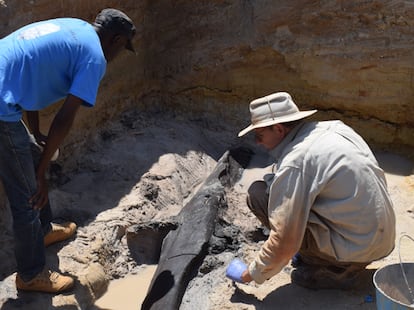Humans were already building with wood in the Stone Age, half a million years ago
The discovery in Zambia suggests that structural use of wood emerged much earlier than previously thought

Two intentionally interlocking logs and a series of tools made of wood could change what is known about Early Stone Age hominins. A discovery in the Kalambo River basin in Zambia shows that humans were building structures with this material at least 476,000 years ago, much earlier than previously thought possible. Although it is not known with certainty what use these artifacts were put to, researchers behind the discovery say they appear to be part of a structure, perhaps “a raised platform, a shelter or something else entirely.”
What is clear is that the hominins of southern Africa, half a million years ago, transformed their environment to make life easier. Professor Larry Barham, from the Department of Archeology at the University of Liverpool (United Kingdom), published the discovery in the journal Nature and said that this discovery has changed the way he thinks about our early ancestors.
This discovery could challenge the prevailing view that humans were nomads half a million years ago, in the middle of the Lower Paleolithic, the most remote stretch of the Stone Age. In present-day Zambia, the artifacts were located next to the 235-meter-high Kalambo Falls, a constant source of water that is surrounded by a forest that would have provided these hominins with food. These conditions would have allowed them to settle, creating the need to build structures.
Until now, evidence of human use of wood was limited to making fires, digging sticks and spears, but the findings of this new study go further. They are remains of modified pieces of wood, which correspond to two phases of hominin occupation in the Kalambo archaeological zone, located on the border of Zambia and the Rukwa region in Tanzania. The first is a structure made of two interlocking logs, worked to fit together thanks to a groove in the upper log, dating back to about 476,000 years ago. In a second phase, between 390,000 and 324,000 years ago, there is evidence of smaller artifacts, including a wedge and a digging stick. Experts had never ruled out the use of wood by Lower Paleolithic hominins, but it remained in the realm of speculation and this is the first direct evidence.
The researchers found stone tool marks on the two large pieces of wood, suggesting a deliberate attempt to make them fit together. The use of tools to make other tools is a characteristic behavior of the Homo genus. However, there are very few examples of structures created by hominids in the Stone Age, and evidence of the modification of structural elements is even more rare.
Wooden structures, carved with stone
Archaeologists’ understanding of the use of wood as a raw material during the course of hominin evolution is limited by its preservation. Generally, wood rots and disappears, so it is not common to find artifacts made of this material in such ancient sites. But the permanent high water levels in the Kalambo area preserved the pieces until they were discovered in 2019 by the team from the British universities of Liverpool and Aberystwyth.
Given the rarity of wooden archaeological records, researchers had to use modern techniques to determine its age. Luminescence dating techniques revealed the last time the sand surrounding the finds was exposed to sunlight. Professor Geoff Duller from Aberystwyth University, a research collaborator, has noted that this area had already been excavated in the 1960s, when researchers recovered other pieces of wood, but these could not be dated and their meaning had remained unclear.
The archaeological discovery not only advances the emergence of woodworking in Africa, but also broadens our understanding of the technical skills of early humans. The Algerian archaeologist Mohamed Sahnouni, from the National Center for Research on Human Evolution, in Burgos, highlights the relevance of the discovery: “It is important to know the cognitive abilities of hominins. It seems very likely that they used construction to make life easier in their environment.”
Sign up for our weekly newsletter to get more English-language news coverage from EL PAÍS USA Edition








































